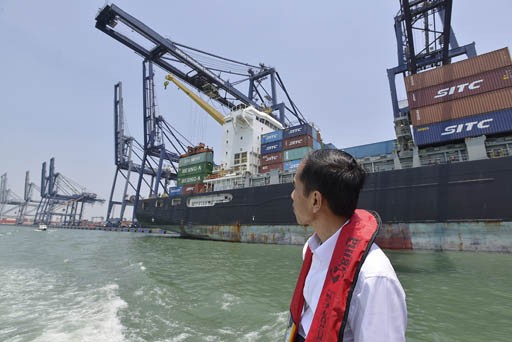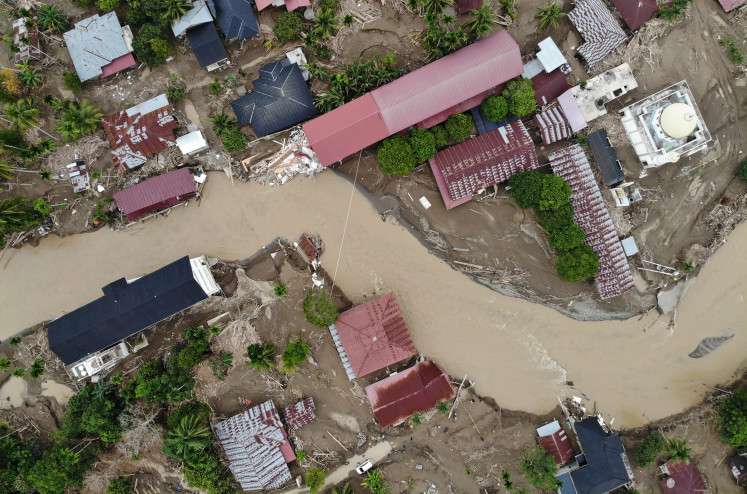Popular Reads
Top Results
Can't find what you're looking for?
View all search resultsPopular Reads
Top Results
Can't find what you're looking for?
View all search resultsAddress frontier regions
The border areas of Kalimantan, for example, have a socio-economy which is very much oriented to the territory of neighboring countries. This is because of strong cultural and economy influence from neighboring countries. If not taken seriously, the development gap with neighboring countries has the potential to invite insecurity; national, political and economic.
Change text size
Gift Premium Articles
to Anyone
 Sea toll road project: Jakarta Governor and president -elect Joko "Jokowi" Widodo inspects Tanjung Priok Port in North Jakarta in September, 2014. Seeming to disregard the urgency of equality, the development system in Indonesia is still very centralized despite decentralization laws. Development is centered in Java and Bali. (Antara/ -)
Sea toll road project: Jakarta Governor and president -elect Joko "Jokowi" Widodo inspects Tanjung Priok Port in North Jakarta in September, 2014. Seeming to disregard the urgency of equality, the development system in Indonesia is still very centralized despite decentralization laws. Development is centered in Java and Bali. (Antara/ -)
I
ndonesia is one of the largest archipelagic countries in the world. In addition to diverse geography, its biodiversity and human resources have also made Indonesia a country with abundant development potential.
In terms of economy, Indonesia holds a pivotal role in global interaction and is among the 20 most powerful economies. Having been hit hard by a prolonged financial crisis in 1998 the Indonesian economy has improved significantly.
Currently, Indonesia, boasting a nominal GDP value amounting to US$895 billion, is ranked 16th on a list of global economic powers. In fact, the Economist Intelligence Unit predicted that Indonesia will become the fourth largest economic power, with an expected GDP of $15.4 trillion by 2050.
However, although the macroeconomic sectors depict agreeable attainment, the distribution of wealth per capita at the grassroots level, is sadly the opposite. Development progress is not matched by equitable distribution of income across the nation, especially in those frontier, outermost and least developed regions often referred to as 3T ( terdepan, terluar, tertinggal ) regions.
Based on last year’s presidential regulation, the 3T regions are less developed, with less people compared to other regions. Through this definition, to date, there remain 122 ( previously 183 ) regions referred to as 3T.
Seeming to disregard the urgency of equality, the development system in Indonesia is still very centralized despite decentralization laws. Development is centered in Java and Bali. Java itself is packed with 60 percent of all Indonesian citizens ( approximately 130 million ) and, ironically, the island only constitutes 7 percent of Indonesian territory.
The development policy that widens the gap between regions creates multi-layered problems and the lack of equitable growth policy causes a dilemma for future national development.
Inequality often ignites conflict and issues of regional jealousy. The emerging of 3T separatist movements in Indonesia such as Free Aceh Movement ( GAM ) and Free Papua Movement ( OPM ) reinforce dissatisfaction with the government because of a lack of equitable development and ideological stance.
However, according to Andrea Azqy, there is growing perception that the issue of the border region is simply about security ( external threat ) because Indonesia has a history of conflict with neighboring countries. Of course, such perception misdirects development, using military approach without any sufficient priority optimizing natural and human resources.
Transmigration, poverty alleviation, development of disadvantaged and border areas, self-sufficiency program and transportation systems are some examples of programs that cannot be implemented optimally because of imbalanced infrastructure and human resources development and unequal distribution of capital in and outside of Java.
The border areas of Kalimantan, for example, have a socio-economy which is very much oriented to the territory of neighboring countries. This is because of strong cultural and economy influence from neighboring countries. If not taken seriously, the development gap with neighboring countries has the potential to invite insecurity; national, political and economic.
Indonesia should begin to pay serious attention to its own lands. There are at least two immediate steps that the government should carry out to mitigate the problems in 3T regions: First, increasing the concern of the government to develop 3T regions and remote areas so that they can develop quickly and keep pace with development of other areas.
The development approach in such regions, in addition to community empowerment, can be done through a scheme of special allocation funds, public service obligation and universal service obligation.
It is also necessary to strengthen economic activities among areas which are strategically growing within one development area.
Second, developing border areas by changing the direction of development policies to be more outward-looking so that the region can become the gateway for economic and trade activities with neighboring countries. However, the development undertaken must not merely focus security but also involve a prosperity approach.
Government should provide a comprehensible capacity building program for the public, government officials and institutions. Such an empowerment program can be addressed to indigenous communities in 3T regions, to improve their prosperity through intensive assistance program for farmers, fishermen, migrants and small and medium entrepreneurs, especially to sources of capital and micro-credit programs guaranteed by the government.
As we all know, the main problem of underdevelopment in the border regions and 3T area is due to development policies which tend to be “inward looking”, as if the border regions are simply the backyard of the country’s development. As a result, the border areas are not considered a priority area of development by central and local governments.
That said, providing a sustainable program to ensure improvement in the quality life among the people in 3T areas is key for development. However, such a program requires long-term effort; the results cannot be enjoyed in the short term. The consistency of policies and planning related to programs of development equity is also very important.
***
The writer is a social activist and lecturer in Pamane Talino Teaching College, Landak, West Kalimantan.
---------------
We are looking for information, opinions, and in-depth analysis from experts or scholars in a variety of fields. We choose articles based on facts or opinions about general news, as well as quality analysis and commentary about Indonesia or international events. Send your piece to community@jakpost.com.









